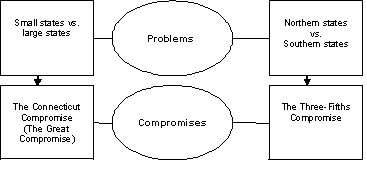The fighting between the French and British during the French and...
The __________ Amendment prohibits cruel and unusual punishment.
___________ divided government power between the federal, or national,...
The President can _______ acts of Congress he does not approve of.
Name of the pamphlet written by Thomas Paine that attacked the...
Popular soverignty is/means:
On March 5, 1770, a crowd of colonists began taunting and throwing...
The "Three-Fifths Compromise" stated that every five _______ counted...
The Royal Proclamation of 1763 declared that colonists could not...
One way in which the authors of the Constitution tried to create...
At the suggestion of Thomas Jefferson, the colonies formed
To assist customs officers in arresting smugglers, the Revenue Act...
On September 11, 1777, General Howe defeated General Washington at the...
The Philadelphia Delegates created a clear system for making changes...
The local militias in the colonies fought differently than the...
Sent by George Washington to spy on the British
One way in which the United States Constitution differed from the...
At the Constitutional Convention of 1787, delegates from the small...
The authors of the United States Constitution believed that the voice...
Which factor has made the strongest contribution to the development of...
What did the Federalists promise to add to the Constitution after...
The winter quarters for the Continental Army
The colonists protested the Stamp Act by
The Confederation Congress was not given power to:
On the night of December 25, 1776, George Washington led approximately...
The Articles of the Confederation gave the Confederation Congress all...
Place of an astonishing American victory and a turning point in the...
Which phrase from the Declaration of Independence most clearly...
The first skirmish of the French and Indian War occurred because
In the French and Indian War, Spain sided with the British.
People pushing for ratification of the Constitution called themselves:
Fighting between the British and French that began in 1754 in North...
Shays' Rebellion started because:
The United States Government is considered a federal system because
The purpose of the Albany Conference was to negotiate
Congressional leaders feared that if New York fell without a fight, it...
Licenses to private ship owners authorizing them to attack British...
The system of checks and balances is best illustrated by the power of
In the summer of 1775, most members of the Second Continental Congress...
Which action was necessary to change from the indirect to the direct...
The laws known as the “Intolerable Acts” were the Coercive Acts...
In the Gaspee Affair,
Which was not a compromise reached during the Constitutional...
Which present-day state was not part of the Northwest Territory in the...
The Virginia Plan would benefit:
After the Boston Massacre, the British brought peace to the colonies...
The delegate chosen as presiding officer of the Constitutional...
Amending the Constitution requires:
People living in the Appalachian Mountains who were outraged at...
The elastic clause, the amending process, and judicial review are all...
In response to the Sugar Act, some colonists argued that the British...
Perhaps the most famous naval battle of the war happened near Britain...
The Albany Plan of Union proposed that
Led the most famous small militia unit in the South
What cause resulted in the effect shown in the diagram above? (Save to...
People with greater income saw Shays's Rebellion as a sign that:
After the Revolutionary War, the taxes and restrictions the states...
In the treaty that ended the French and Indian War, the British gained...
News of Shays' Rebellion and unrest elsewhere convicted the Congress...
King George III declared the colonies “open and avowed enemies”...
















